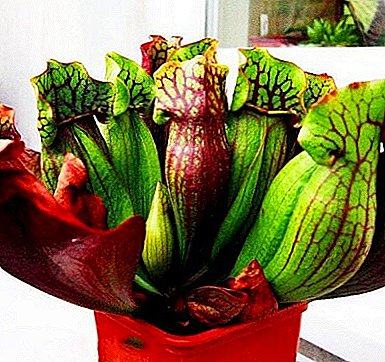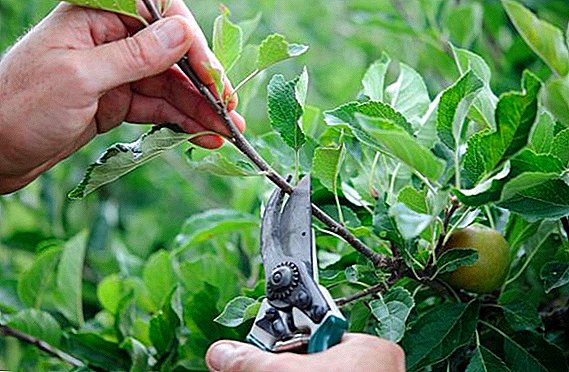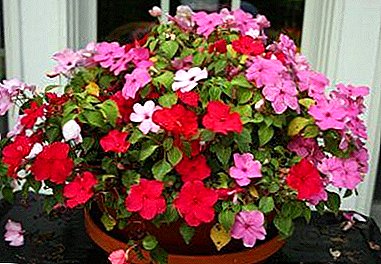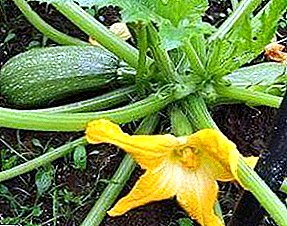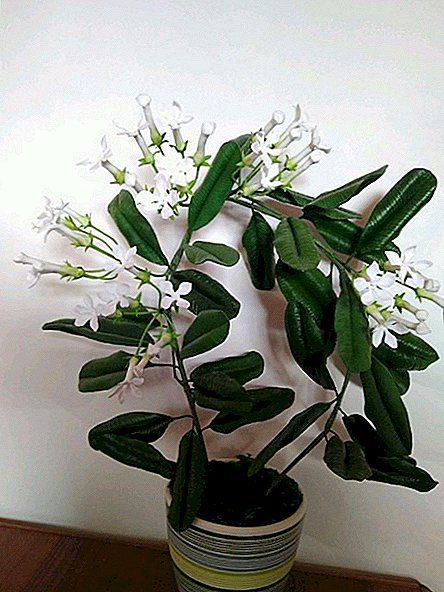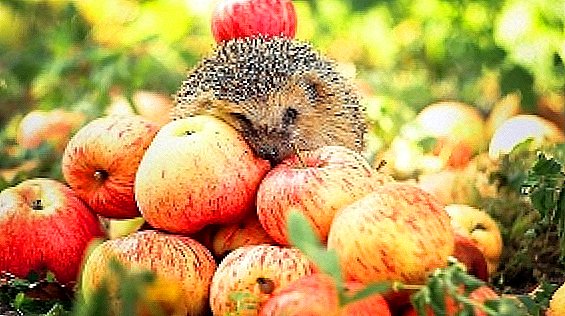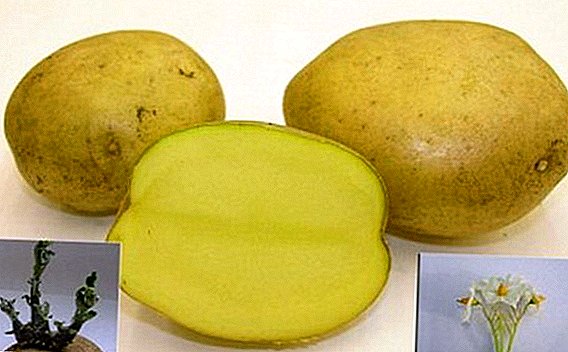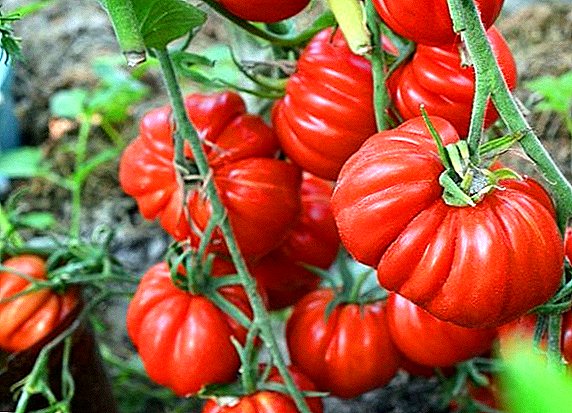 Tomato "Tlakolula de Matamoros" is famous not only for its original name, but also for its excellent characteristics. Tomato has an unusual shape, amazing taste, while unpretentious care and does not require special conditions for growing. Let's find out what else is remarkable this variety.
Tomato "Tlakolula de Matamoros" is famous not only for its original name, but also for its excellent characteristics. Tomato has an unusual shape, amazing taste, while unpretentious care and does not require special conditions for growing. Let's find out what else is remarkable this variety.
Variety description
Tomato "Tlakolula de Matamoros", the birthplace of which is Mexico, belongs to the late, tall and high-yielding varieties. A peculiarity of a tomato is its unusual, pear-shaped and ribbed form: the fruit is wide below, the top is narrow. The top is yellow and the rest is red.

Did you know? The name of the plant received from the name of a small Mexican town Tlakolula (Tlacolula) de Matamoros, from which spread the first seeds.
The bush is tall, its height can reach 2 meters. It develops quickly and well - soon there appear long brushes in the amount of 3-7 pieces, on which fruits later ripen. "Tlakolula de matamoros" ripens 90-100 days after sowing seeds.
This variety has several varieties:
- Pink or Pink. Got its name because of the color of the fruit. Tomatoes have a rounded shape, sometimes pear-shaped. Tomato has a pleasant, slightly sweet taste, due to the content of a large amount of sugar in it. Pink is recommended for people who are allergic to red foods.

- Yellow. Differs in saturated yellow color, a ridge form. The flesh is juicy and extremely tender, resembles a chrysanthemum in the section.

- White. Rarely grown on the territory of our state, because it is capricious in care, it requires a lot of time and effort. Tomato pulp is juicy and at the same time dense, similar in taste to fruit rather than vegetables.

Important! Collectible types of tomatoes are very capricious and whimsical in care. Therefore, in order to get a good harvest and high quality of fruits from them, it is necessary to provide them with appropriate conditions that will require a lot of time and effort from gardeners.
Fruit characteristics and yield
A distinctive feature of "Tlakolula de Matamoros" is a pronounced ribbed surface of a tomato, reminiscent of mandarin slices. The color of tomatoes can vary, depending on the variety: from white and yellow to pink and rich red. The weight of one fruit is from 100 to 300 g.
Ripens the plant at 90-100 days after sowing. For maximum yield, 1-2 stems should be formed. Fruit bushes appear on the bushes, where from 3 to 7 tomatoes ripen in each brush.
This variety has excellent taste. Tomatoes have a pleasant tomato flavor with amazing sweet notes. They are used fresh or for the preparation of salads, various dishes, preparations for the winter, etc.

Selection of seedlings
Usually the cultivation of "Tlakolula de Matamoros" is carried out outdoors, in rare cases outside. For planting plants should purchase seedlings that appear on the markets and in stores in late May.
Indeterminate varieties, like Tlakolula de Matamoros, require careful maintenance, but their yield is high. Check out the characteristics of the tomatoes "Honey", "Puzata hata", "De barao black", "Jubilee Tarasenko", "Makhitos", "Grapefruit", "Rapunzel", "Black Prince", "Niagara", "Japanese truffle", "Pink Flamingo", "Mazarin", "Kumato", "Grandma".
When choosing seedlings, one should pay attention to the following signs:
- Root system Roots must be strong, not dry and not rotten.
- Stem. In a good plant, it is durable, dense, uniform color without dark spots. Ideal thickness - with a pencil or a little thicker. Plant height should not exceed 30 cm, and the number of leaves - 10-12.
- Foliage. The leaves should have a characteristic tomato smell, have a rich green color, do not have any stains, blotches or black. It is very important to visually inspect the underside of the leaves to make sure that there are no pest eggs. Please note that too saturated, unnatural green color of the leaves, which are also curled down, indicates that a large amount of mineral fertilizers were used during its cultivation. It is better not to take such seedlings.
- Age of seedlings. The best option are young plants, age 45-60 days.

Soil and fertilizer
Tomatoes, though not whimsical in cultivation, will not grow on any soil. They are not suitable too wet soil with an excess of organic fertilizers. This variety prefers a rather loose, saturated with nutrients, moderately moist, slightly acidic and warm soil. Feels bad in the shade.
The peculiarity of salad varieties is the taste and the presence of a large amount of pulp, the bright representatives are “Monomakh's Hat”, “Batyana”, “Golden Domes”, “Slots f1”, “One Hundred Poods”, “Madeira”, “Japanese Crab”, “Pink Honey "," Pink Giant "," Bokele "," Ox Heart "," Hospitable. "
Tomatoes are excellently acclimatized in areas where zucchini, legumes, cabbage, onions, and cucumbers were previously grown.
Before the landing itself, the ground should be carefully prepared:
- make mineral fertilizers and humus;
- well loosen and moisturize;
- clean from weeds.

Growing conditions
"Tlakolula de mathamoros" is a thermophilic variety that, when grown, requires good lighting and sufficient temperature. If the plant is provided with good lighting for 12-16 hours, it can form two stems, otherwise only one. On one bush, 5-6 brushes are left, the tip is pinched, and only two leaves are left above the top brush.
As for the temperature, it is very important to monitor its level and not to allow an increase. With strong heat, the plant will wilt, turn yellow and shed its leaves. The optimum temperature is in the range of 20-25 ° C.
It is equally important to ensure good moisture culture. At the same time, the tomato is very sensitive to overflow. It is recommended to water it when the topsoil is completely dry. After planting the tomato seedlings should be moistened abundantly, and to prevent the rapid evaporation of moisture, the ground can be covered with a layer of straw or mulched with peat.

Every two weeks it is necessary to make mineral fertilizers and organic, based on 1 square. m - 10 l of solution. In the period of the formation of the fruits as a top dressing use magnesium sulfate.
Important! When applying fertilizer should be guided by the rule: "It is better to underfeed than overfeed."
Growing from seed to seedlings at home
If there are doubts about the quality of the purchased seedlings, it can be grown at home.
Seed preparation
Since this variety is collection, it is recommended to purchase seeds exclusively in specialized stores. To grow seedlings need to carry out the following manipulations:
- seeds are checked for germination, the gulf is filled with a small amount of water - those grains that go down are used to grow seedlings;
- high-quality seeds pour a weak solution of potassium permanganate for 20 minutes;
- carry out the "hardening" of the grains, placing them in a cold place for 2-3 days, and then in the open air;
- seed treated with growth promoter.
Find out how you can process tomato seeds.

Content and locations
It is recommended to grow seedlings in small pots or plastic cups, from which it can be easily transferred to open ground, or in specially made shallow boxes.
Seed planting process
For planting previously treated seeds, it is better to use loose, moist soil, which is disinfected before sowing to avoid the development of fungi.
Important! The stage of disinfection of soil should not be missed, otherwise pathogens will destroy future sprouts.
In the ground, make a small depression to 1.5 cm, where one seed is placed.
If disembarkation is carried out in boxes, then:
- the container is filled with moist soil and make small grooves up to 1.5 cm deep;
- seeds are sown at a distance of 4-5 cm from each other;
- pits sprinkled with a small layer of soil;
- the soil is abundantly moistened;
- The container is covered with glass or plastic wrap to create a favorable microclimate with a constant humidity of 80-90%.
Video: planting tomatoes for seedlings
Care of seedlings
After sprouting the shoots, the film must be removed to provide them with sufficient illumination. Next, the plant is watered moderately as the soil dries. It should not be poured, because excess moisture has a negative effect on the emerging root system and may cause it to rot.
After 3 weeks after emergence of seedlings, it is necessary to dive - transplant into separate containers, deepening the stems to the cotyledon leaves. At this time, the plant is better not to make under direct sunlight. 2 weeks after transplantation, it is recommended to feed sprouts using special products or bird droppings.
Learn how to feed tomato seedlings.A few weeks before planting in open ground, they begin to harden. To do this, the plant is carried out daily on the street, for 2 hours. One day before planting, seedlings are carried out for the whole day.
Video: how to swoop tomatoes
Transplanting seedlings in the greenhouse
After 60 days after sowing, seedlings need to be transplanted into the greenhouse. This should be done in the evening. Sprouts are planted in fairly deep holes, up to 18-20 cm, at a distance of half a meter from each other. It is recommended to put 50 g of wood ash mixed with the soil at the bottom of the pit, and add humus and turf in equal proportions to the soil itself.
Learn more about how to plant tomatoes in the greenhouse.When the bushes grow a little, they bow, pulling the stem on the ground and a little sprinkling soil. Tomato requires good watering.
Two weeks later, the plant is treated with a 1% solution of Bordeaux liquid, which will protect it from parasites and various diseases.
Did you know? Considering that the large, bright red fruits of tomatoes resemble the heart, the French gave them the name "pomme d'amour" - "love apples".
 "Tlakolula de matamoros" in the greenhouse
"Tlakolula de matamoros" in the greenhouse
Agricultural technology of growing tomato seeds in the open ground
Fulfilling the main standards of agricultural technology and timely caring for the crop, even an inexperienced gardener can achieve good yield from it. Often the Tlakolula de Matamoros cultivar is grown in greenhouses, however, in areas with a warm climate, the plant will yield in open ground.
Outdoor conditions
The technology of growing tomatoes in closed ground is quite simple and is excellent for the variety "Tlakolula de Matamoros". But the yield of the plant will depend not on the place of its growth, but on the proper and timely care, which is due to proper watering, loosening, feeding, forming a bush.
Growing "Tlakolula" in the open field - a risky business, however, if you follow all the recommendations, it is quite real.

- Of course, the timing of planting seedlings in indoor and outdoor ground are different. Landing in the latter case is carried out when the threat of possible frosts passes.
- Tomatoes are light-loving plants, so it is better for them to choose fairly lighted areas, but without direct sunlight, without drafts and strong winds.
- It is recommended to plant tomatoes on elevated areas where there is no water stagnation.
- It is recommended to prepare the land for cultivation in the fall: apply fertilizer to the soil, remove the weeds.
- It is imperative to determine the level of soil acidity before planting, since its increased concentration slows down the growing season.
- The best precursors for tomatoes are cucumbers, zucchini, carrots, onions, beans.
- Areas with fresh manure are not suitable for planting.
The process of planting seedlings in open ground
It is better to organize the landing activities on an overcast day or in the late afternoon. The seed method of growing tomatoes is more suitable for areas with a very warm climate, but in regions with moderate weather conditions it is better to use the seedling method.

Seedlings, which are previously sown from seeds, are planted as follows:
- Dig a hole to a depth of 20 cm.
- At its bottom make a little peat and humus, 1 tbsp. l superphosphate, 0.5 tbsp. l ash and 1 tsp. magnesium sulfate.
- Seedlings are placed in the ground so that the two lower side stems are fully immersed in the soil, especially upright, sprinkling with soil only the hole.
- The distance between the bushes should be about 30 cm, between rows - at least 70 cm.
Important! Before planting seedlings in the ground, you should make sure that weeds such as horsetail, oxalis, and sorrel do not grow nearby, which contribute to an increase in soil acidity.
Watering
Tomatoes varieties "Tlakolula de matamoros" must be watered exclusively at the root, without affecting the foliage. Moistening of seedlings is recommended to begin two weeks after its disembarkation. The plant loves quite abundant watering - at least 1 liter of settled, not cold water under one bush.
When grown in a greenhouse, other rules for irrigation and fertilizer apply.At the same time, the tomato tolerates excessive moisture over wetness. In rainy weather it is better not to water it; on cloudy days, the amount of watering should be reduced to two times a week, and in a hot period, moisture should be increased more often, as the topsoil dries.

If, due to the density of the soil, the water is poorly absorbed, you should make several vertical punctures with a pitchfork or peg. After the liquid is completely gone, it is recommended to conduct a gentle loosening of the soil.
Soil loosening and weeding
In the process of growing a tomato requires regular earthing up and weeding. Such activities will accelerate the development of the root system and increase the flow of nutrients from the soil. Hilling is carried out twice: during flowering and fruit formation. Soil loosening is carried out after each feeding.
Weeding the plants is carried out as necessary, avoiding the overgrowth of bushes. Weeding should be carried out immediately after heavy rainfall, since the moistened soil is a good medium for the active growth of various weeds.
Tomatoes especially need clean ground:
- when planting seedlings;
- during the period of intensive growth;
- during flowering and ripening tomatoes.

Did you know? From a botanical point of view, the fruit of a tomato is not a vegetable, but a large, juicy berry.
Masking
The stocking of tomatoes - the formation of bushes - should begin in early June, two weeks after planting. This process will remove extra, weak shoots, thereby strengthening and improving the plant, as well as correctly distribute the supply of nutrients to the foliage and fruit.
To determine which stepson should be removed, first you need to find where the first flower brush comes from. Under this brush is the stem, which will be necessary stepchild. All stepchildren better pinch off their hands without using a knife or blade. Masking is ideally carried out every 10-12 days.
If the plant is not formed, the real jungle is formed on the bed. In "Tlakolula de Matamoros" it is necessary to leave 1-2 stems, which will grow about 5-7 brushes with flowers. The formation of the bush is to remove the lower foliage, while between the leaves and the ground should form a distance of at least 30 cm
After the brush is formed, you need to pinch the tip to stop the growth of the plant up.
When the fruits begin to ripen, it is necessary to remove all dried and old leaves from the bush.

Garter
In the process of sprawling bush tomato can reach a height of 2 meters, so it must be tied up. If this is not done, the stems may break under a large mass, and the fruits in contact with the ground will begin to deteriorate.
There are several ways to garter tomatoes:
- Traditional methodwhen the plant is tied to a hammered wooden or metal pole. For each individual bush uses a separate peg. As a subwoofer material, it is better to use soft cloth strips, various non-rigid straps. It is strictly forbidden to tie up with a line or thin ropes that will pinch the stem.
- Shpaler method. Lanes are installed at a certain distance from each other, between them horizontally tension the wire. Between the rows of wire retain a distance of about 45 cm. To this design are attached rows of tomatoes.
- Linear way. Its essence lies in the fact that between the pegs in the center they stretch the wire, to which a rope stretches from each bush. In this case, one end of the rope is fixed on the stem.
- Cellular mode. For each tomato bush, a special cell (frame) of wire is created. The pieces of wire are bent in an arc and horizontally joined by other pieces. Next, the cell digs into the ground to a depth of 15 cm, and the bush is tied with a rope.

Important! Often, the cause of the disease of tomatoes is last year's garter - old diseases are “transmitted” to the plant. That is why for tying you need to use only new ropes.
It should be remembered that a competent garter is one of the main factors influencing the quality of the crop and its volume.
Top dressing
Tomatoes need regular feeding, it is especially important to ensure it during the flowering and fruit formation. Fertilizers are recommended to be applied in the late afternoon in order to prevent tomatoes from burns.
Means for feeding should be selected based on the condition of the tomatoes:
- if the plant looks sickly, and its green has a pale color, you need to take care of adding organic matter to the soil, for example, mullein;
- yellow foliage indicates an excess of phosphorus;
- if foliage becomes purple, you need to increase the amount of phosphorus;
- the rapid growth of the bush indicates an excess of nitrogen fertilizers;
- when there is spotting on the leaves, it is necessary to reduce the feeding with potassium.

Fertilizers should be applied in the dosage indicated on the packages, if purchased means are used. You can prepare the solution yourself, from 1 kg of manure to 10 liters of water. Top dressing of tomatoes must be combined with watering.
Check out the nuances of pollinating tomatoes in the greenhouse.
Pests, diseases and prevention
Diseases of tomatoes can manifest themselves both in greenhouse conditions and in the open field. Diseases are:
- viral type;
- fungal type;
- bacterial type.
- Bronze - manifested by wilting of foliage and its twisting. Plants that live in greenhouses are most often affected by this disease. Brown spots are formed on the fruits, which later appear on the leaves. This disease cannot be cured, but at 45 ° C the effect of viruses stops.
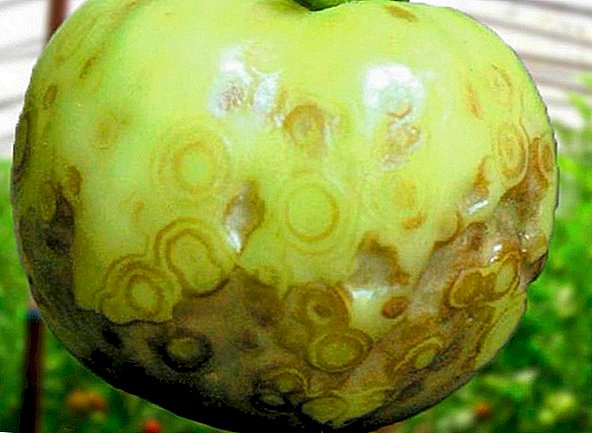 Bronze tomato on the fruit
Bronze tomato on the fruit - Yellow Curly - it is easy to determine by the appearance of the fruit: they become aesthetically unattractive, uneven color with divorces on the surface. In addition, the virus, which is caused by whitefly, leads to curling and deformation of the leaves.
 Yellow curl on tomato leaves
Yellow curl on tomato leaves - Bushy top - affects the greenhouse plant in winter: leaves twist and stretch into a tube, small dots appear on them, which later grow into white spots. As a result of such exposure, tomatoes develop poorly and rarely produce crops. There is no protection against this disease, for its prevention they carry out treatment with agromechanics.
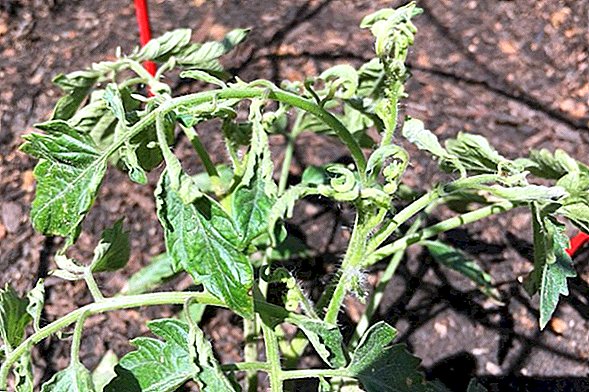
Learn how to cure tomatoes in a greenhouse.
Fungal diseases affect leaves, stalks and fruits. Among them, the most common:
- Late blight - Its sign is the appearance of dark-brown spots of irregular shape on the stems. In the future, these spots are interconnected, forming dead skinning interceptions. At the same time, there is no characteristic fungal plaque on the leaves and stem. To get rid of late blight, it is recommended to sterilize the soil, completely remove the diseased tomatoes, and treat healthy plants with special preparations, for example, sodium humate or "Pseudo-bacterin".
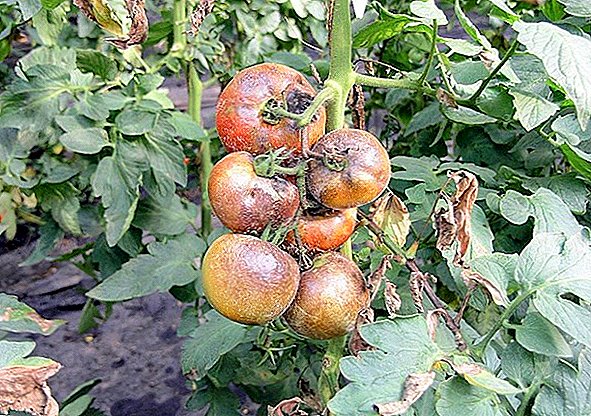
- Gray rot - A very serious disease for Tlacoloula that affects the entire stem, with the result that the tissues completely die. Visually, ailment can be recognized by the presence of a gray-white bloom on the green, which infects the whole plant, because of which it fades. The danger of this disease lies in the fact that it can be transmitted to a number of growing crops. In the fight against gray mold used chemicals, such as "Bayleton".
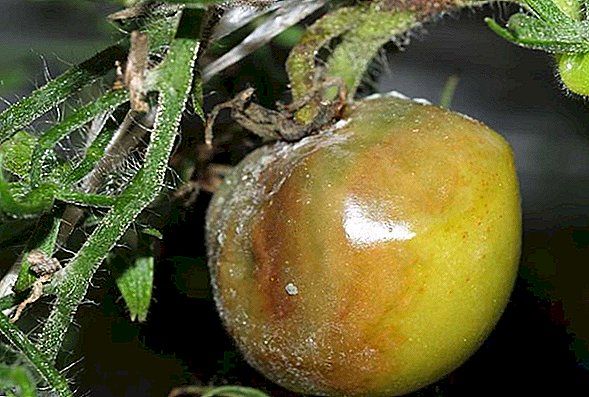
- White rot (sclerotinia) - Can be formed in places of mechanical damage to the bush. Able to increase with sudden changes in temperature (hot day and cold night), after heavy rains. Symptoms of the disease are: putrid stalk lesions, wilting plants, fluffy plaque. Getting rid of the source of infection will help disinfect the soil.
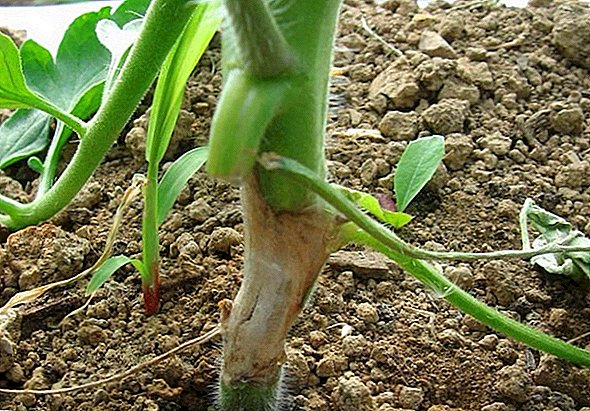 White rot of tomato stem
White rot of tomato stem
Not only diseases are dangerous for tomatoes, familiar with common tomato pests.Of the bacterial diseases, gardeners most often encounter such:
- Mottling - it is very easy to recognize it: brown speckled spots form on the leaves. The most comfortable conditions for the development of the disease are elevated levels of humidity and low temperature. In greenhouses, this disease occurs extremely rarely. To combat it use chemicals, which are dominated by copper.
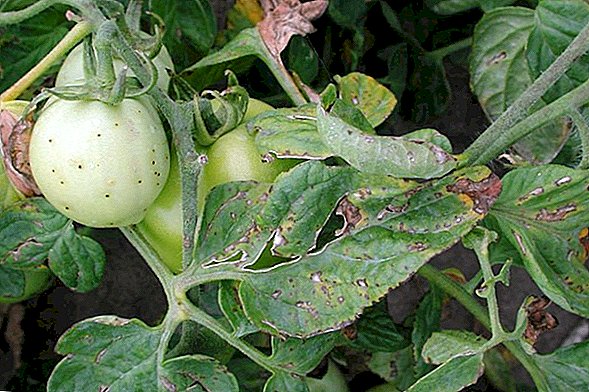
- Wet rot - affects the fruit, and both already ripe and green. On them, spots are first formed, which later begin to rot and are transformed into a mass of liquid consistency with an unpleasant pungent odor. For the prevention of disease, it is necessary to provide the necessary temperature and humidity level during storage and transportation of fruits, as well as to eliminate pests by means of special preparations.
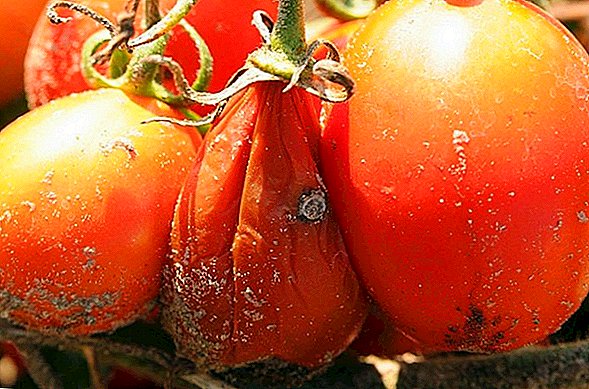 Wet Rot of Tomato Fruits
Wet Rot of Tomato Fruits
Harvesting and storage
Crop of tomatoes harvested as they ripen. If they do not have time to fully mature, then they are torn off, put in a basket and placed in a warm, dry place.
Important! Tomatoes grown on the beds, stored longer than greenhouses.
Tomatoes "Tlakolula" are very vulnerable and sensitive to transportation, so they should be processed immediately. The best place to store tomatoes are cool, dry places, with temperatures ranging from 5 ° C to 12 ° C and a relative humidity of no more than 80%.
Fruits are recommended to put the stalk up in wooden or plastic boxes. To maximize the shelf life of tomatoes, before packing them into the container, you need to sort them - remove all rotten, damaged, unripe fruits. Do not wash the tomatoes.

Possible problems and recommendations
Tomatoes "Tlakolula de Matamoros" are easy to care for and unpretentious in cultivation. Like other types of tomatoes, they love the sun, warm weather, moderate moisture. However, gardeners may experience some problems in the process of plant development:
- The temperature in the greenhouse is too high. It is imperative to monitor the temperature, otherwise with strong heat the flowers begin to dry and fall, which leads to the absence of fruit ovaries.
- Low water temperature. For moistening you need to use distilled warm water. It is forbidden to water the tomatoes with cold water.
- Overflow. Although tomatoes of this variety like abundant watering, they are not recommended to be poured, as this can lead to the death of the plant. At the same time, insufficient watering of tomatoes during flowering of seedlings can lead to the absence of ovaries, and during ripening of fruits - to their drooping.
- Top dressing. Fertilizers should be applied every two weeks, and alternating their types: mineral with organic. The dosage of feeding is: 1 bucket per 1 square. m square. The lack of fertilizers primarily affects the state of the leaves: they become yellow, dry, begin to wilt and eventually fall off. The same applies to green fruits, which, with a lack of phosphorus and potassium, begin to simply crumble.
- Masking With poor lighting in the greenhouse spend staking in one stalk, with good - in two. This procedure is required for good growth, development and yield of tomatoes.

High yield, excellent taste of the fruit, ease of cultivation - all these are the main properties of the tomato "Tlacoloula de mathamoros". Despite the exotic name and overseas origin, this species has got acclimatized in our area and was loved by many summer residents. Knowing the features of agrotechnology, you can effortlessly grow ribbed tomatoes, which are very useful both in fresh form and as ingredients for many dishes.
Sort "Tlakolula de mathamoros": reviews

I try to buy L. Krasavavitsa for the second year, but for the time being I’m not lucky, in the first year I started looking for seeds late, and in the second I made an order, and they’ll take it and finish: D
Girls, who grew 100 pounds from Aelitovsky seeds, but what about their re-export? I sowed Aelitovsky tomatoes twice, and both times the return was, I don't even know, I am “lucky” or the company is sinning.






 Bronze tomato on the fruit
Bronze tomato on the fruit Yellow curl on tomato leaves
Yellow curl on tomato leaves


 White rot of tomato stem
White rot of tomato stem
 Wet Rot of Tomato Fruits
Wet Rot of Tomato Fruits